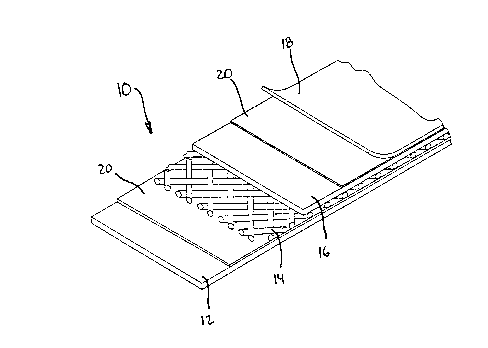Some of the information on this Web page has been provided by external sources. The Government of Canada is not responsible for the accuracy, reliability or currency of the information supplied by external sources. Users wishing to rely upon this information should consult directly with the source of the information. Content provided by external sources is not subject to official languages, privacy and accessibility requirements.
Any discrepancies in the text and image of the Claims and Abstract are due to differing posting times. Text of the Claims and Abstract are posted:
| (12) Patent: | (11) CA 2171050 |
|---|---|
| (54) English Title: | LAMINATED VAPOR BARRIER |
| (54) French Title: | ECRAN D'ETANCHEITE STRATIFIE |
| Status: | Expired and beyond the Period of Reversal |
| (51) International Patent Classification (IPC): |
|
|---|---|
| (72) Inventors : |
|
| (73) Owners : |
|
| (71) Applicants : |
|
| (74) Agent: | SMART & BIGGAR LP |
| (74) Associate agent: | |
| (45) Issued: | 2001-02-27 |
| (22) Filed Date: | 1996-03-05 |
| (41) Open to Public Inspection: | 1996-11-27 |
| Examination requested: | 1996-03-05 |
| Availability of licence: | N/A |
| Dedicated to the Public: | N/A |
| (25) Language of filing: | English |
| Patent Cooperation Treaty (PCT): | No |
|---|
| (30) Application Priority Data: | ||||||
|---|---|---|---|---|---|---|
|
A vapor barrier laminate for use in insulation applications as
a facing material. A fiberglass yarn or scrim is positioned
between layers of kraft paper. An aluminum foil is adhered directly
to the outer kraft paper layer. The paper to foil bond and the
paper to paper bond are accomplished with a flame retardant
adhesive. The resulting heavier and thicker laminate provides
increased rigidity, a smoother outer surface for better abrasion
resistance, and a greater tensile strength. Use of the laminate in
duct board facing improves the strength of the duct board while
facilitating tape adherence for sealing gaps between board
sections.
Note: Claims are shown in the official language in which they were submitted.
Note: Descriptions are shown in the official language in which they were submitted.

2024-08-01:As part of the Next Generation Patents (NGP) transition, the Canadian Patents Database (CPD) now contains a more detailed Event History, which replicates the Event Log of our new back-office solution.
Please note that "Inactive:" events refers to events no longer in use in our new back-office solution.
For a clearer understanding of the status of the application/patent presented on this page, the site Disclaimer , as well as the definitions for Patent , Event History , Maintenance Fee and Payment History should be consulted.
| Description | Date |
|---|---|
| Time Limit for Reversal Expired | 2008-03-05 |
| Letter Sent | 2007-03-05 |
| Inactive: IPC from MCD | 2006-03-12 |
| Inactive: Late MF processed | 2004-03-22 |
| Grant by Issuance | 2001-02-27 |
| Inactive: Cover page published | 2001-02-26 |
| Inactive: Final fee received | 2000-12-06 |
| Pre-grant | 2000-12-06 |
| Notice of Allowance is Issued | 2000-06-12 |
| Notice of Allowance is Issued | 2000-06-12 |
| Letter Sent | 2000-06-12 |
| Inactive: Approved for allowance (AFA) | 2000-05-24 |
| Amendment Received - Voluntary Amendment | 1999-10-22 |
| Inactive: S.30(2) Rules - Examiner requisition | 1999-04-22 |
| Inactive: Status info is complete as of Log entry date | 1997-12-30 |
| Inactive: Application prosecuted on TS as of Log entry date | 1997-12-30 |
| Application Published (Open to Public Inspection) | 1996-11-27 |
| Request for Examination Requirements Determined Compliant | 1996-03-05 |
| All Requirements for Examination Determined Compliant | 1996-03-05 |
There is no abandonment history.
The last payment was received on 2000-12-21
Note : If the full payment has not been received on or before the date indicated, a further fee may be required which may be one of the following
Patent fees are adjusted on the 1st of January every year. The amounts above are the current amounts if received by December 31 of the current year.
Please refer to the CIPO
Patent Fees
web page to see all current fee amounts.
| Fee Type | Anniversary Year | Due Date | Paid Date |
|---|---|---|---|
| Request for examination - standard | 1996-03-05 | ||
| MF (application, 2nd anniv.) - standard | 02 | 1998-03-05 | 1997-12-22 |
| MF (application, 3rd anniv.) - standard | 03 | 1999-03-05 | 1998-12-17 |
| MF (application, 4th anniv.) - standard | 04 | 2000-03-06 | 1999-12-15 |
| Final fee - standard | 2000-12-06 | ||
| MF (application, 5th anniv.) - standard | 05 | 2001-03-05 | 2000-12-21 |
| MF (patent, 6th anniv.) - standard | 2002-03-05 | 2002-02-04 | |
| MF (patent, 7th anniv.) - standard | 2003-03-05 | 2003-02-24 | |
| MF (patent, 8th anniv.) - standard | 2004-03-05 | 2004-03-22 | |
| Reversal of deemed expiry | 2004-03-05 | 2004-03-22 | |
| MF (patent, 9th anniv.) - standard | 2005-03-07 | 2005-02-21 | |
| MF (patent, 10th anniv.) - standard | 2006-03-06 | 2006-02-17 |
Note: Records showing the ownership history in alphabetical order.
| Current Owners on Record |
|---|
| COMPAC CORPORATION |
| Past Owners on Record |
|---|
| CHARLES J. PETTY |